高一英语第二单元教案模版
- 格式:docx
- 大小:33.78 KB
- 文档页数:11
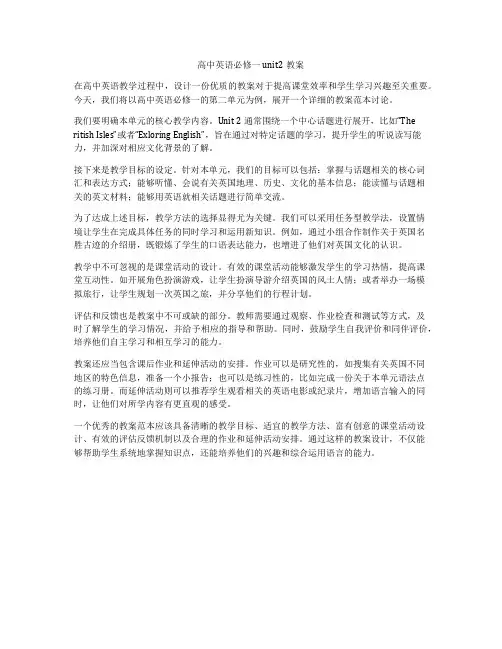
高中英语必修一unit2教案在高中英语教学过程中,设计一份优质的教案对于提高课堂效率和学生学习兴趣至关重要。
今天,我们将以高中英语必修一的第二单元为例,展开一个详细的教案范本讨论。
我们要明确本单元的核心教学内容。
Unit 2通常围绕一个中心话题进行展开,比如“The ritish Isles”或者“Exloring English”,旨在通过对特定话题的学习,提升学生的听说读写能力,并加深对相应文化背景的了解。
接下来是教学目标的设定。
针对本单元,我们的目标可以包括:掌握与话题相关的核心词汇和表达方式;能够听懂、会说有关英国地理、历史、文化的基本信息;能读懂与话题相关的英文材料;能够用英语就相关话题进行简单交流。
为了达成上述目标,教学方法的选择显得尤为关键。
我们可以采用任务型教学法,设置情境让学生在完成具体任务的同时学习和运用新知识。
例如,通过小组合作制作关于英国名胜古迹的介绍册,既锻炼了学生的口语表达能力,也增进了他们对英国文化的认识。
教学中不可忽视的是课堂活动的设计。
有效的课堂活动能够激发学生的学习热情,提高课堂互动性。
如开展角色扮演游戏,让学生扮演导游介绍英国的风土人情;或者举办一场模拟旅行,让学生规划一次英国之旅,并分享他们的行程计划。
评估和反馈也是教案中不可或缺的部分。
教师需要通过观察、作业检查和测试等方式,及时了解学生的学习情况,并给予相应的指导和帮助。
同时,鼓励学生自我评价和同伴评价,培养他们自主学习和相互学习的能力。
教案还应当包含课后作业和延伸活动的安排。
作业可以是研究性的,如搜集有关英国不同地区的特色信息,准备一个小报告;也可以是练习性的,比如完成一份关于本单元语法点的练习册。
而延伸活动则可以推荐学生观看相关的英语电影或纪录片,增加语言输入的同时,让他们对所学内容有更直观的感受。
一个优秀的教案范本应该具备清晰的教学目标、适宜的教学方法、富有创意的课堂活动设计、有效的评估反馈机制以及合理的作业和延伸活动安排。
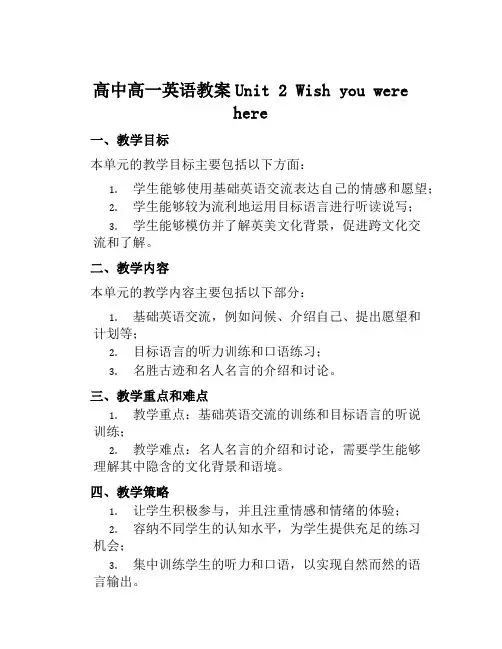
高中高一英语教案Unit 2 Wish you werehere一、教学目标本单元的教学目标主要包括以下方面:1.学生能够使用基础英语交流表达自己的情感和愿望;2.学生能够较为流利地运用目标语言进行听读说写;3.学生能够模仿并了解英美文化背景,促进跨文化交流和了解。
二、教学内容本单元的教学内容主要包括以下部分:1.基础英语交流,例如问候、介绍自己、提出愿望和计划等;2.目标语言的听力训练和口语练习;3.名胜古迹和名人名言的介绍和讨论。
三、教学重点和难点1.教学重点:基础英语交流的训练和目标语言的听说训练;2.教学难点:名人名言的介绍和讨论,需要学生能够理解其中隐含的文化背景和语境。
四、教学策略1.让学生积极参与,并且注重情感和情绪的体验;2.容纳不同学生的认知水平,为学生提供充足的练习机会;3.集中训练学生的听力和口语,以实现自然而然的语言输出。
1. Warm-up首先,通过进行小组内的问候和介绍,激发学生的兴趣和情感共鸣。
老师可以引导学生谈论课上愉快或不愉快的事情、计划或期望等。
2. Presentation接着,老师可以用简单的场景,如介绍城市名胜,来展示目标语言并说明相关的语法和表达方式,并向学生提供一些基本的单词和短语,以便于他们更好的理解和使用。
3. Practice有了基本的语言基础,学生可以进行相应的口语训练,以巩固所学知识。
为了更好的体现实用性,这部分可以通过学生模拟进行小场景对话和表演。
老师可以通过分组小游戏、角色扮演等方式来营造轻松愉快的氛围,让学生更多地参与到其中。
4. Production在学生逐渐熟悉基础英语交流后,老师可以引导学生讨论和分析名人名言,学习其中的文化内涵和思想精髓。
同时,再通过模拟抒发心声来模拟真实场景,促进学生的交际能力和跨文化交流能力。
5. Conclusion最后,老师可以进行小结和回顾,并邀请学生分享他们学习过程中的愉快或有趣的事情。
同时,老师也可以对学生的表现作出评价并鼓励他们继续努力。
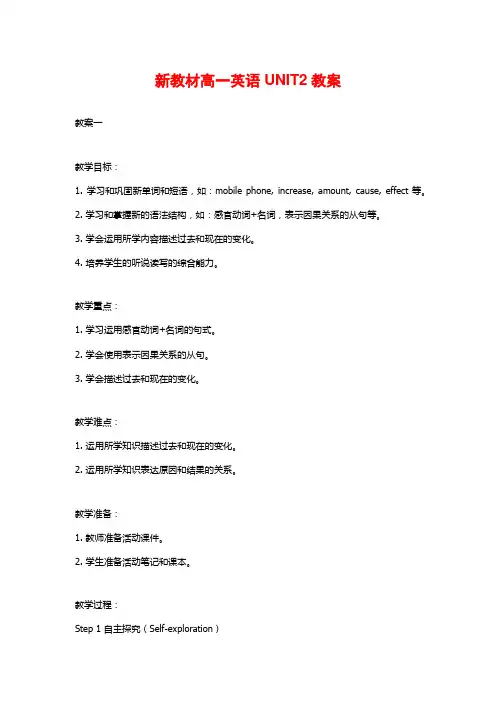
新教材高一英语UNIT2教案教案一教学目标:1. 学习和巩固新单词和短语,如:mobile phone, increase, amount, cause, effect等。
2. 学习和掌握新的语法结构,如:感官动词+名词,表示因果关系的从句等。
3. 学会运用所学内容描述过去和现在的变化。
4. 培养学生的听说读写的综合能力。
教学重点:1. 学习运用感官动词+名词的句式。
2. 学会使用表示因果关系的从句。
3. 学会描述过去和现在的变化。
教学难点:1. 运用所学知识描述过去和现在的变化。
2. 运用所学知识表达原因和结果的关系。
教学准备:1. 教师准备活动课件。
2. 学生准备活动笔记和课本。
教学过程:Step 1 自主探究(Self-exploration)1. 学生观察并记录图片上的物品,用感官动词表示出来。
如:I can hear the sound of music.2. 学生合作讨论向导读教材的时间转移。
3. 学生观察后记录方法,总结并检查记录是否准确。
Step 2 知识讲解(Presentation)1. 教师出示一组单词卡片,并引导学生将其与画出的物品进行匹配。
学生边匹配边发音、拼读。
2. 教师讲解词义、用法和拼读,并让学生读一遍。
3. 教师通过图片和例句,介绍句式“感官动词+名词”。
Step 3 合作探究(Cooperation)1. 学生跟随教师的指导,以分组为单位合作完成课本练习。
2. 学生重新组合词语并创造句子。
3. 学生相互交换伴读和合作完成课本练习。
Step 4 巩固练习(Consolidation)1. 学生独立完成教材的听力任务并记录自己的回答。
2. 学生合作完成书本上的阅读任务。
引导学生通过阅读图表和文章,分析原因和结果。
Step 5 总结归纳(Summary)1. 教师引导学生总结所学知识点,强调关键内容。
2. 学生展示所做的笔记和课本上的解答。
3. 教师进行总结归纳,提醒学生复习和回顾。

高中英语必修一第二单元教案一、教学任务及对象1、教学任务本教案针对的是高中英语必修一第二单元的教学内容。
该单元的主题为“友谊”,旨在帮助学生掌握与友谊相关的词汇、语法、句型,培养学生在实际语境中运用英语进行交流的能力,同时加强学生的听说读写综合技能。
教学内容包括:词汇学习(如:friendship, loyal, trustworthy等)、语法点(如:一般现在时、一般过去时)、课文理解、听力训练、口语表达以及写作练习。
2、教学对象本教案的教学对象为高中一年级学生,他们在初中阶段已经具备了一定的英语基础,但在高中阶段需要进一步提高英语综合运用能力。
学生们的英语水平参差不齐,因此,在教学过程中需要关注每一个学生的学习需求,因材施教,使他们在原有的基础上得到提高。
在教学过程中,要注意激发学生的学习兴趣,培养他们自主、合作、探究的学习习惯,帮助他们树立正确的学习观念,使他们在轻松愉快的氛围中学习英语,提高英语素养。
同时,要关注学生的情感需求,营造一个和谐、友善的课堂氛围,让他们在友谊的陪伴下共同成长。
(1)掌握与友谊相关的词汇、语法、句型;(2)运用所学知识进行听说读写实践活动;(3)理解课文内容,提高阅读理解能力;(4)培养良好的学习习惯,提高英语综合运用能力;(5)树立正确的友谊观,懂得珍惜友谊。
在此基础上,教师应运用多种教学策略,关注每一个学生的成长,使他们在英语学习中获得全面发展。
二、教学目标1、知识与技能(1)词汇:学生能够掌握本单元的基本词汇,如friendship, loyal, trustworthy, support, communicate等,并能够在实际语境中正确运用。
(2)语法:学生能够理解并掌握一般现在时和一般过去时的用法,能够运用这两个时态进行句子构建和文章写作。
(3)听力:学生能够听懂与友谊相关的对话和短文,提高听力理解能力,并能够抓住关键信息进行答题。
(4)口语:学生能够在日常生活中使用英语进行与友谊话题相关的交流,表达自己的观点和感受,提高口语表达能力。
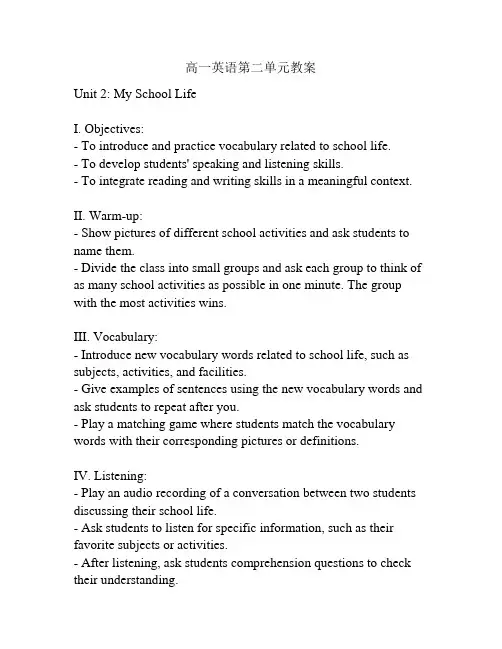
高一英语第二单元教案Unit 2: My School LifeI. Objectives:- To introduce and practice vocabulary related to school life.- To develop students' speaking and listening skills.- To integrate reading and writing skills in a meaningful context. II. Warm-up:- Show pictures of different school activities and ask students to name them.- Divide the class into small groups and ask each group to think of as many school activities as possible in one minute. The group with the most activities wins.III. Vocabulary:- Introduce new vocabulary words related to school life, such as subjects, activities, and facilities.- Give examples of sentences using the new vocabulary words and ask students to repeat after you.- Play a matching game where students match the vocabulary words with their corresponding pictures or definitions.IV. Listening:- Play an audio recording of a conversation between two students discussing their school life.- Ask students to listen for specific information, such as their favorite subjects or activities.- After listening, ask students comprehension questions to check their understanding.V. Speaking:- Divide the class into small groups and ask each group to discuss their favorite subjects and activities in school.- Provide sentence starters, such as "My favorite subject is..." or "I enjoy doing..." to help students express their thoughts.- Monitor the groups and provide feedback on pronunciation and grammar errors.VI. Reading:- Provide students with a passage about a typical school day and ask them to read it silently.- Ask comprehension questions to check their understanding of the text.- Have students read the passage out loud to practice their pronunciation.VII. Writing:- Ask students to write a short paragraph about their own school life, including their favorite subjects, activities, and facilities.- Provide a writing template with sentence starters to help students organize their thoughts.- Collect and assess the students' writing for grammar, vocabulary, and organization.VIII. Extension activities:- Play a game of charades, where students act out different school activities without speaking and the class guesses what they are.- Ask students to create a poster about their school life, including pictures and captions.IX. Homework:- Assign a writing task where students have to describe their ideal school life.- Provide a checklist for students to ensure they include all the necessary information.X. Assessment:- Monitor students' participation during class discussions and group activities.- Assess students' written work using a rubric based on grammar, vocabulary, and organization.。
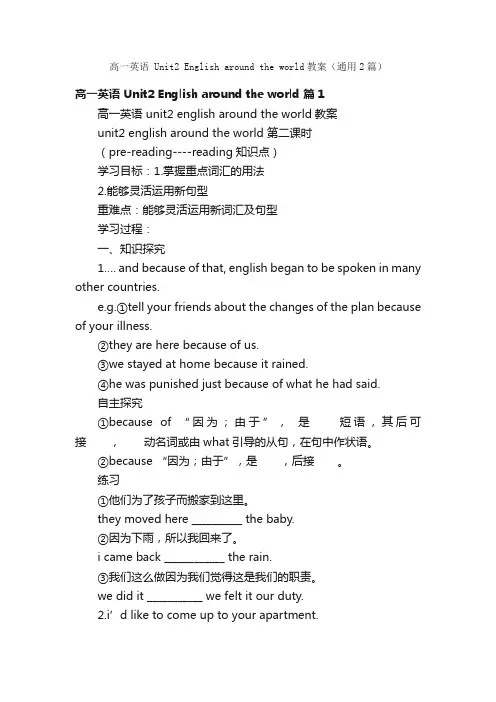
高一英语 Unit2 English around the world教案(通用2篇)高一英语 Unit2 English around the world 篇1高一英语 unit2 english around the world教案unit2 english around the world 第二课时(pre-reading----reading知识点)学习目标:1.掌握重点词汇的用法2.能够灵活运用新句型重难点:能够灵活运用新词汇及句型学习过程:一、知识探究1…. and because of that, english began to be spoken in many other countries.e.g.①tell your friends about the changes of the plan because of your illness.②they are here because of us.③we staye d at home because it rained.④he was punished just because of what he had said.自主探究①because of “因为;由于”,是短语,其后可接,动名词或由what引导的从句,在句中作状语。
②because “因为;由于”,是,后接。
练习①他们为了孩子而搬家到这里。
they moved here __________ the baby.②因为下雨,所以我回来了。
i came back ____________ the rain.③我们这么做因为我们觉得这是我们的职责。
we did it ___________ we felt it our duty.2.i’d like to come up to your apartment.猜测下列句子中come up 的词义。
①the little by came up to the stranger and showed him how to get to the police station.②we won’t forget the day when we watched the sun come up on top of the tai mountain.③it is certain that the question will come up at the meeting.④the snowdrops are just beginning to come up. _⑤i am afraid something urgent has come up. ____短语归纳come 邂逅come 向…扑来,攻击 come 来自 come 出版;开花;结果是come 想出,发现,提出come 发生come 绕道而来 come 落下,塌下指点迷津come up /come up with①come up 意为“被提及”时,其主语是被提出的内容,不能用于被动语态。

Unit 2 Reading and Thinking 教学设计1.教师带领学生回顾非谓语动词三种形式。
1. 介绍动词v-ing形式相关知识结构:“do+ing” 构成, 其否定形式是“not doing”, V-ing 可以带宾语或状语构成V-ing 短语, 没有人称和数的变化, 但有时态和语态的变化。
2.动词v-ing形式作状语的用法。
读句子,思考以下问题:①. V-ing 作状语可以表示哪些情况?②. V-ing 作状语应注意什么?1) Hearing the bell, the students rushed to the school canteen.2) Not knowing the answer to this question , he turned to his deskmate.3) The two girls stood there for half an hour talking about the boys who were playing basketball.4) The COVID-19 broke out throughout the world,causing hundreds of thousands of deaths.5) Working harder, you will make some progress.作用:动词-ing形式是非谓语动词的一种,兼有动词和形容词的特征,在句中可作表语,定语,宾语补足语和状语,一般表示进行或主动的意思。
动词-ing形式用作状语时,其逻辑主语必须与句子的主语一致,动词-ing形式所表示的动作和句子的主语是主动关系。
板书:Homework:1. Finish the exercises in Learning English.2. Preview Listening and Talking on page 7.课后反思本节课的学习目标基本达成,学生能够运用动词v-ing形式较熟练描述人物行为。
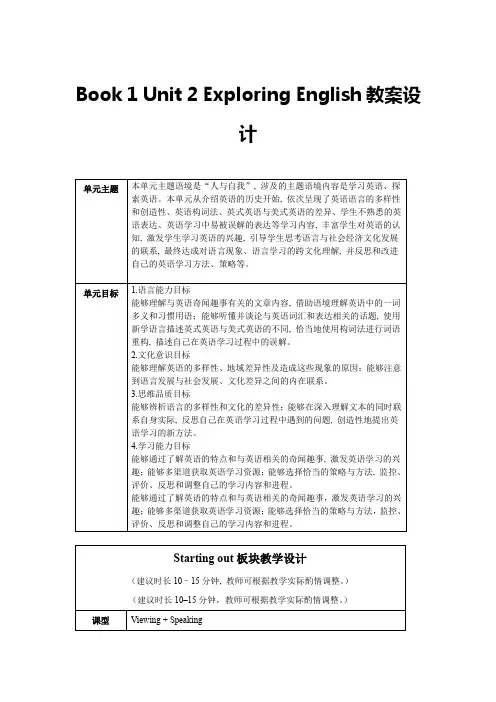
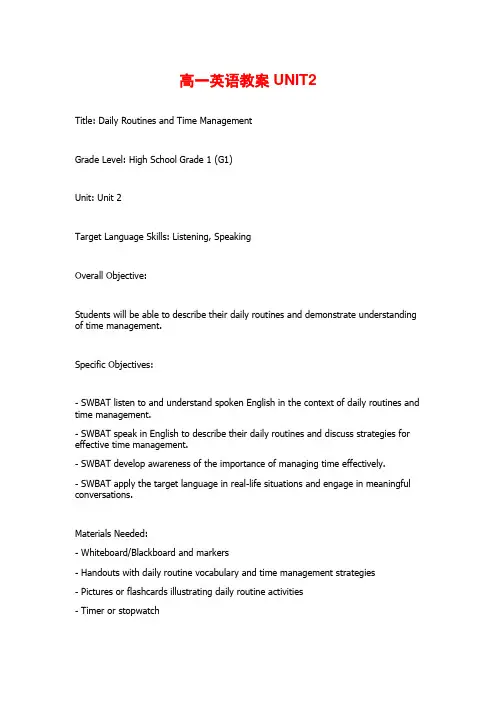
高一英语教案UNIT2Title: Daily Routines and Time ManagementGrade Level: High School Grade 1 (G1)Unit: Unit 2Target Language Skills: Listening, SpeakingOverall Objective:Students will be able to describe their daily routines and demonstrate understanding of time management.Specific Objectives:- SWBAT listen to and understand spoken English in the context of daily routines and time management.- SWBAT speak in English to describe their daily routines and discuss strategies for effective time management.- SWBAT develop awareness of the importance of managing time effectively.- SWBAT apply the target language in real-life situations and engage in meaningful conversations.Materials Needed:- Whiteboard/Blackboard and markers- Handouts with daily routine vocabulary and time management strategies- Pictures or flashcards illustrating daily routine activities- Timer or stopwatchLesson 1: Daily Routines VocabularyIntroduction (10 minutes):- Begin the lesson by asking students what they typically do on a regular school day. Lead a class discussion about common daily routines.- Introduce and elicit different vocabulary words related to daily routines, such as wake up, get dressed, have breakfast, go to school, do homework, etc.- Write the vocabulary words on the board and have the students repeat them after you.Work in Pairs (15 minutes):- Divide the class into pairs. Give each pair a set of flashcards or pictures illustrating daily routine activities.- Instruct the pairs to take turns holding up a flashcard or picture and describing the activity in English to their partner. Encourage them to use the vocabulary words they just learned.Listening Activity (10 minutes):- Play a recording or read out a short dialogue about daily routines for students to listen to.- Ask comprehension questions about the dialogue to ensure students understood the content.Lesson 2: Time Management StrategiesIntroduction (10 minutes):- Give students handouts with different time management strategies, such as making to-do lists, setting goals, prioritizing tasks, etc.- Explain the importance of time management and how it can help individuals be more organized and productive.- Go through each strategy briefly and provide examples to illustrate their application.Pair Discussion (15 minutes):- In pairs, have students discuss the time management strategies they find most effective and why.- Encourage them to share their own experiences and give advice to their partners.Role-play Activity (15 minutes):- Divide the class into groups of four and assign each group a scenario related to time management (e.g. planning a study schedule for exams).- Each group should discuss and role-play their scenario, using the time management strategies they have learned.- Monitor the groups and provide feedback on their language use and application of the strategies.Wrap-up (5 minutes):- Have a class discussion about the role-play scenarios and what the groups learned about effective time management.- Recap the key vocabulary and time management strategies discussed during the lesson.- Assign a short homework task related to time management, such as creating a to-do list for the next day.Note: These lesson plans are only suggestions and can be adjusted or modified based on the needs and abilities of the students.。
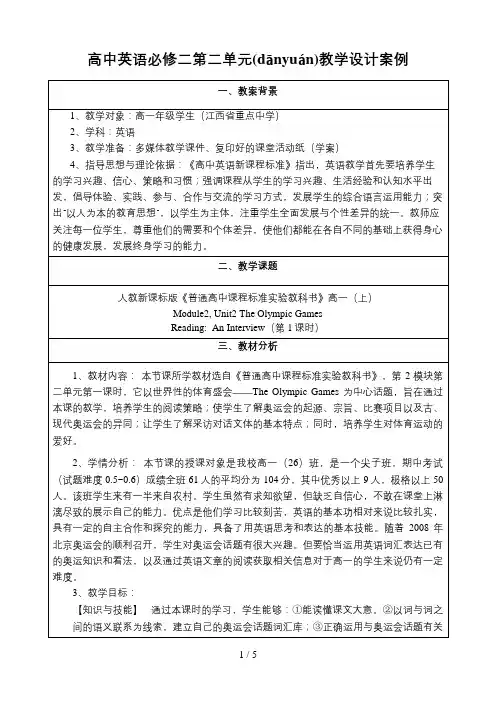
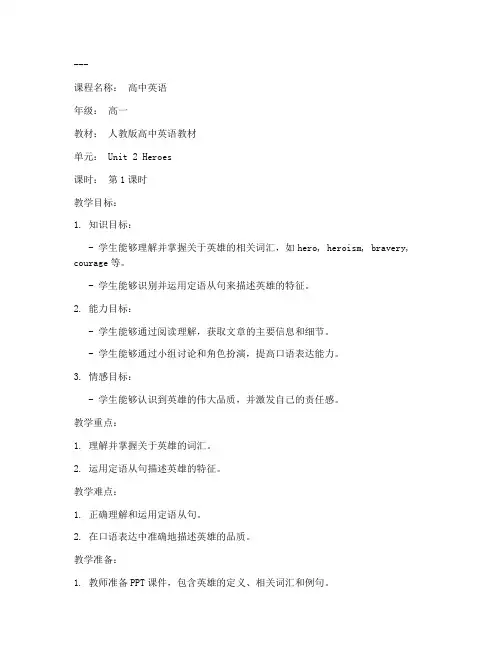
---课程名称:高中英语年级:高一教材:人教版高中英语教材单元: Unit 2 Heroes课时:第1课时教学目标:1. 知识目标:- 学生能够理解并掌握关于英雄的相关词汇,如hero, heroism, bravery, courage等。
- 学生能够识别并运用定语从句来描述英雄的特征。
2. 能力目标:- 学生能够通过阅读理解,获取文章的主要信息和细节。
- 学生能够通过小组讨论和角色扮演,提高口语表达能力。
3. 情感目标:- 学生能够认识到英雄的伟大品质,并激发自己的责任感。
教学重点:1. 理解并掌握关于英雄的词汇。
2. 运用定语从句描述英雄的特征。
教学难点:1. 正确理解和运用定语从句。
2. 在口语表达中准确地描述英雄的品质。
教学准备:1. 教师准备PPT课件,包含英雄的定义、相关词汇和例句。
2. 教师准备图片或视频资料,用于激发学生的学习兴趣。
3. 教师准备小组讨论和角色扮演的道具。
教学过程:一、导入(5分钟)1. 利用图片或视频展示不同领域的英雄,如体育明星、科学家、历史人物等。
2. 引导学生思考:什么是英雄?英雄有哪些品质?二、新课导入(10分钟)1. 展示PPT,介绍英雄的定义和相关词汇。
2. 通过例句讲解定语从句的用法,并让学生跟读。
三、课文阅读(15分钟)1. 学生独立阅读课文,标注不熟悉的词汇和句子。
2. 教师提问,检查学生的阅读理解情况。
四、小组讨论(15分钟)1. 将学生分成小组,讨论以下问题:- 课文中的英雄有哪些品质?- 你认为谁是你的英雄?为什么?2. 每组选派代表分享讨论结果。
五、角色扮演(15分钟)1. 教师分配角色,让学生扮演课文中的英雄。
2. 学生根据角色进行对话,展示英雄的品质。
六、总结与作业(5分钟)1. 教师总结本节课的学习内容,强调英雄的伟大品质。
2. 布置作业:- 写一篇关于你心目中英雄的短文。
- 收集并整理关于英雄的资料,准备下一节课的展示。
板书设计:Heroes- Definition: A person who is admired for their courage, achievements, or noble qualities.- Qualities: Bravery, courage, determination, kindness, etc.- Examples: Sports stars, scientists, historical figures, etc.Words and Phrases:- Hero- Heroism- Bravery- Courage- Determination- Kindness结语:本节课通过词汇讲解、课文阅读、小组讨论和角色扮演等活动,帮助学生理解和掌握关于英雄的知识,同时提高学生的口语表达能力和团队合作精神。
高中unit2英语教案一、教学目标1. 知识与技能:掌握本单元的核心词汇和语法结构,能正确使用新学的单词和短语进行交流。
2. 过程与方法:通过各种教学活动,培养学生的听说读写综合技能,特别是提高阅读理解能力和口语交际能力。
3. 情感态度与价值观:通过对本单元话题的探讨,引导学生形成积极的学习态度,增强跨文化交际意识。
二、教学内容1. 核心词汇:确保学生能够掌握并正确使用本单元的关键词汇。
2. 语法焦点:重点讲解并练习本单元的语法点,如时态、语态、非谓语动词等。
3. 阅读材料:分析课文内容,讨论主题思想,提炼文章结构。
4. 听力训练:通过听力练习,提高学生的听力理解能力。
5. 口语实践:组织角色扮演、辩论等活动,加强口语表达及实际应用能力。
6. 写作技巧:指导学生如何根据所学内容撰写英文短文。
三、教学方法1. 互动式教学:鼓励学生参与课堂讨论,实现师生互动。
2. 小组合作:通过分组合作任务,促进学生之间的交流与合作。
3. 任务驱动:设置具体的学习任务,激发学生的学习动力。
4. 多媒体辅助:利用T、视频等多媒体工具,增加教学的趣味性和直观性。
四、教学过程1. 导入阶段:通过提问、小故事或相关视频引入新课内容,激发学生的兴趣。
2. 学习新知:系统讲解新课的词汇和语法点,结合例句加深理解。
3. 操练巩固:通过完成练习题、对话练习等方式,帮助学生巩固所学知识。
4. 应用拓展:安排相关的阅读、听力和写作任务,让学生将所学应用于实际语境中。
5. 小结反馈:总结本节课的学习要点,及时给予学生反馈和指导。
五、作业布置1. 完成课后习题,加强对课堂内容的理解和记忆。
2. 准备一个小报告或短文,以检验对本单元话题的理解和表达能力。
3. 预习下一单元内容,为下一次的英语课做准备。
六、教学反思在每堂课后,教师应进行反思,评估教学效果,了解学生掌握情况,并根据学生的反馈调整教学计划和方法,以达到最佳的教学效果。
高中英语必修一第二单元教案I. Teaching Objectives1. Knowledge Objectives:- Learn about the history and spread of the English language.- Familiarize students with different varieties of English spoken around the world.2. Ability Objectives:- Develop students' reading and listening skills.- Enhance students' ability to express their opinions and thoughts in English.3. Emotional Objectives:- Cultivate students' curiosity and appreciation for different cultures and languages.- Promote students' awareness of the importance of learning English in a global context.II. Teaching Key Points1. Understanding the history and spread of the English language.2. Recognizing and appreciating different varieties of English spoken around the world.3. Developing reading and listening skills through comprehension activities.III. Teaching Difficulties1. Differentiating between varieties of English and understanding their unique characteristics.2. Encouraging students to actively engage in discussions and express their own opinions.IV. Teaching Methods1. Task-based learning: Engaging students in various activities to promote active learning.2. Audio-visual aids: Using multimedia resources to enhance students' understanding and interest.3. Group work: Encouraging students to work collaboratively and interact with their peers.V. Teaching Aids1. Multimedia resources: Videos, audio clips, and images showcasing different varieties of English.2. Handouts: Reading and listening comprehension exercises.VI. Teaching ProceduresStep 1: Warm-up (15 minutes)- Show a world map on the screen and ask students to identify countries where English is spoken as a first language or is widely used.- Introduce the topic by asking students why they think English is considered a global language.- Facilitate a class discussion by encouraging students to share their thoughts and opinions.Step 2: Pre-reading and Vocabulary (10 minutes)- Introduce key vocabulary words related to the topic, such as "lingua franca," "dialect," and "accent."- Provide definitions and examples for each word.- Ask students to use the words in sentences to ensure understanding.Step 3: Reading Comprehension (20 minutes)- Distribute the reading passage about the history and spread of the English language.- Instruct students to read the passage individually and underline any unfamiliar words.- Discuss the passage as a class, focusing on comprehension questions and addressing any difficulties.- Assign additional comprehension exercises for homework.Step 4: Listening Comprehension (20 minutes)- Play an audio clip showcasing different varieties of English spoken around the world.- Discuss the clip as a class, focusing on unique characteristics and variations in pronunciation and vocabulary.- Have students complete a listening comprehension exercise based on the audio clip.Step 5: Group Work (15 minutes)- Divide students into groups and assign each group a different variety of English to research.- Provide guiding questions to help students gather information about the assigned variety.- Instruct groups to present their findings to the class, highlighting unique features and examples of the variety.Step 6: Class Discussion (15 minutes)- Facilitate a class discussion on the importance of learning different varieties of English in a global context.- Encourage students to share their personal experiences or encounters with non-native English speakers and discuss the challenges and benefits of understanding different accents and dialects.Step 7: Summary and Reflection (10 minutes)- Summarize the key points covered in the lesson.- Ask students to reflect on what they have learned and how it has influenced their perspective on English as a global language.- Provide additional resources or activities for further exploration of the topic outside the classroom.VII. Homework- Assign written reflections on the importance of understanding different varieties of English in a global context.- Encourage students to research and find examples of unique features or characteristics of English spoken in different countries.VIII. Assessment- Evaluate students' comprehension through reading and listening comprehension exercises.- Assess students' participation and contribution during group work and class discussions.- Review students' written reflections on the importance of understanding different varieties of English.。
高一英语必修一unit2教案【5篇】高一英语必修一unit2教案【5篇】高一是同学适应高中英语学习的关键时期,作为一名高一英语老师,你知道如何写一篇英语教案?下面是我为你预备的高一英语必修一unit2教案,快来借鉴一下并自己写一篇与我们共享吧!高一英语必修一unit2教案精选篇5教学目标1. To practise listening comprehension.2.To practise making decisions and reasoning教学重难点1. To practise listening comprehension.2.To practise making decisions and reasoning教学工具课件教学过程Step1. revision1. check the homework exercises.1). It has been reported that children will be offered free education.It has been reported that free education will be offered to children.2). It has been said that we will be offered the latest computer science course book.It has been planned that the latest computer science course book will be offered to us.3). I have been told by Peter that I will be lent his notebook computer for a week.I have been told by Peter that his notebook computer will be lent to me for a week.2. Question: What can computers be used as?Step2. Lead-inAs we know, science and technology is developing very fast and computers have become smaller and smaller. They have been used in many fields. So, the 21st century is the century of information technology What does it mean? Does information technology/ IT only mean things like computers? Of cause not. Actually, it means more than computers. Computers are just one kind of IT. What else do you know is part of IT?(TV, radio, CD-ROM, DVD, books……)Step3. Listening (SB)1. Pre-listening: What are the changes brought by different forms of IT ?What are the advantages and disadvantages of them ?2. While-listening:Go through the chart and make sure the students look at the chart before they listen to the tape. (This is to sharpen their attention and listen for the answers. This will also help them get the gist of the text.) Then Listen to the tape and finish filling in the chart. (If necessary, play the tape for several times.)Say: After listening to their talk, we know all kinds of IT have both disadvantages and advantages.Let’s check the answers together.Type of IT Advantages DisadvantagesTV You can both listen and watch. You cannot write to friends.Web You can find information. It is very expensive.Radio You can listen to English. You cannot watch a film.Book You can get information. Sometimes it is out of date.3. Post-listening:1) (pair work): decide which type of IT is best for you to use right now. Make your choice and give your reasons by using the following expressions.I think that….In my opinion, ….I believe that….I agr ee because….I disagree because….I’ve decided that….2) (group work): Discussion :Computers are useful and have brought us lots of good things, but they also cause bad effects. What attitude should we have towards the computer? (Make good use of it but never get trapped by it.)Step4. Speaking1. Pre-speakingSay: From what we have learn, we should admit that computers and the web have a great influence on the school education as well as people’s life. It has come into people’s everyday life and many families hold computers in their homes. Now there is a task for you.2. While-speaking1) Situation: You have been asked by your parents to help choose computers for your home. You and your friend have looked at several computers. Talk about the special things each computer can do. Make a decision about which kind of computer to buy and explain why.Information input: Show students some pictures of different computers (desktop computer laptop computer …)Language input: Useful expressions (Repeat it to strengthen students’ ability of use it.)Supporting an opinion Challenging an opinionI think that … , because … Perhaps, but what if / about …First, … Have you thought about …One reason is that … What makes you think thatI think it is better because… I don’t like it because….(Pair work )Use the expressions to support your opinion or challenging other’s opinions.2) Oral report: (individual work )Do an oral report to your father and start your report like this: I looked at many different computers. The one I have chosen is the PEP personal computer. One of the main reasons is that it is suitable for homes. I found that…3. Post-speakingConclusion—What useful expression do we use to make a decision and reason?(In this way, they can review and use the words and phrases again.)Step6 Pre-writingSay: Imagine what problems and delights this android might have to deal with while it is serving you. Try yourself in someone else’s shoes is an important way of understanding how other people feel.Then discuss: You are an android. You work for a family with one child who is very spoiled. The parents want you to do everything for them. The parents are nice, but they often ask you to watch over their child. How do you feel? What would you do if the child asked you to do his/her homework for him/her? Would you ever tell the child “no”?Step7 WritingSay: Write a passage about the result of your discussion! It should contain:What do you have to do?What is the child like?What is the parents’ requirement of the child?What do the parents want you to do?What does the child want you to do?Then what will you do? How do you feel?Sample writing:Hello everybody, my name is Liu Yan.I am a 321 model android.I work for the Li family. Mr and Mrs Li work very hard too.Mr Li is an architect and designs great tall apartment blocks.Mrs Li is a doctor and has to look after many patients.I remember all the plans for Mr Lis projects and can tell Mrs Li which drugs are the best to give any particular patient. And I also look after their library. I store all the books that they borrow from their school or friends in my brain.Of course my brain is as large as a mountain, so work like that is no trouble to me.I really eat books just like people eat food.The Lis have a child who is very spoiled. He needs me to remember all his school textbooks so that I can do his homework for him.He just gives me the information on the subject, what has to be done and the page numbers and I get on with it while he enjoys himself with his friends.Sometimes I dont think it is right to do his homework for him — its somewhat cheating. However, his parents are very concerned at the pressure of work in school these days.The child has too much homework to do. They like him to go to the key school but they also want him to be able to have hobbies, learn to swim and keep fit! Poor child!So they consider me the most important person in the family after themselves.I am always introduced to their friends and play with visiting children.I am the perfect family academic aid and, although I was not cheap to buy, Mr Li says I was worth every yuan!Step8 AssessmentGet the students to assess their writing ability according to the following the questions:1. Is your composition well developed?2. Are your ideas well organized to the point?3. Do you have a good choice of words and idioms in your writing?4. Do you get a good mastery of complex structures of language?5. What kind of mistakes have you made in your writing?Step9: HomeworkWrite about your discussion. You may begin like this:Hello, everyone. My name is __X. I’m 321 model android.I work for the Li family….课后小结学了这节课,你有什么收获?课后习题完成课后习题一、二。
高中英语必修1第二单元教案一、教学任务及对象1、教学任务本节课的教学任务是基于高中英语必修1第二单元的内容,该单元主要围绕“友谊”这一主题展开,旨在帮助学生掌握与友谊相关的词汇、句型,理解课文内容,并能运用所学知识进行实际情景的交流。
通过本节课的学习,使学生能够运用英语描述自己的朋友,谈论友谊的重要性,以及表达对朋友的关爱和帮助。
2、教学对象本节课的教学对象为高中一年级学生,他们已经在初中阶段积累了一定的英语基础,具备一定的听、说、读、写能力。
但由于学生的英语水平参差不齐,需要在教学中关注个体差异,因材施教,激发学生的学习兴趣,提高他们的英语综合运用能力。
此外,由于高中阶段的学习任务更加繁重,学生往往面临较大的学习压力,因此,在教学过程中要注重培养学生的自主学习能力和合作精神,帮助他们树立正确的学习态度。
二、教学目标1、知识与技能(1)掌握与“友谊”相关的词汇、短语和句型,如:best friend, close friend, bosom friend, make friends, spend time with, share with, be loyal to等;(2)运用所学词汇和句型,描述自己的朋友,谈论友谊的重要性和表达对朋友的关爱;(3)理解并运用一般现在时和一般过去时描述朋友之间的互动;(4)提高英语听力、口语、阅读和写作能力,尤其是口语交流能力和阅读理解能力;(5)学会使用英语词典、网络资源等工具,拓展英语学习渠道。
2、过程与方法(1)采用任务型教学法,设计丰富多样的教学活动,如小组讨论、角色扮演、情景模拟等,激发学生的学习兴趣,培养合作精神;(2)鼓励学生主动参与课堂,积极思考,大胆表达,提高学生的自主学习能力;(3)通过课文阅读、听力训练、口语练习等多种形式,帮助学生掌握语言知识,提高语言技能;(4)利用多媒体教学手段,如PPT、视频、音频等,丰富教学资源,提高教学效果;(5)创设真实语境,让学生在实际运用中巩固所学知识,提高语言运用能力。
高一英语教案UNIT2教学目标•掌握词汇:vocabulary about jobs, skills and abilities•理解并能运用英语中有关工作、技能和能力的句子结构•学会用英语描述自己的兴趣、职业倾向以及技能特长•培养学生合作学习和沟通交流的能力•提高学生的听说读写综合能力教学准备•教材:教材《高中英语》•工具:投影仪、计算机、教案、录音机等教学过程Warm up1.Let’s start today’s class with a brainstorming activity. Ask the students to think about different jobs they are familiar with and write them on the board. Allow a few minutes for students to come up with ideas. Then, invite volunteers to share their ideas.2.As a group, discuss the skills and abilities required for each job. Write these on the board as well. Encourage students to think outside the box and consider both technical and personal skills.Presentation1.Introduce the vocabulary words related to jobs, skills, and abilities. Write each word on the board and provide a brief definition if necessary. Use visual aids or gestures to help students understand the meanings.2.Give examples of sentences using the vocabulary words, and ask students to repeat after you. Focus on sentence structures that describe jobs, skills, and abilities.–Example:。
高一英语unit2教案【篇一:人教版英语必修一第二单元-unit2教学设计】unit2 english around the worldreading the road to modern english教学设计高一英语李海娟一、教材分析本单元的中心话题是“世界英语”,介绍了英语在世界上的重要性。
warming-up 简要介绍了英语语言在不同国家的差异,是学生对英国英语和美国有了粗浅的了解。
pre-reading的问题是针对阅读课文的赌钱思考,激活学生已获背景知识,激发学生阅读的兴趣。
reading “a road to modern english”简要说明了英语语言的起源、发展变化、形成原因及发展趋势。
本课的语言知识主要围绕世界英语这一中心话题进行设计。
本课时主要分为三部分:1. pre- reading (读前准备) 此部分为热身活动2. reading (阅读)3. post-reading (读后)二、教学目标:1. 学生通过阅读文章能够从篇章结构的角度出发描述英语语言发展的历史过程2. 学生能够在阅读过程中对主要的阅读信息进行记录。
3. 学生能够了解英语在世界上的发展情况,意识到学习英语的重要性的同时,也要热爱自己的祖国,热爱自己的母语。
三、教学步骤step 1 leading-in (individual work)1. do you like learning english? and why?2. can you name some countries in which english is spoken?show a word map on the blackboard and the students to find out the countries in which people use english as their own language. then ask one or two students to mark thesecountries on the map. (通过层层设置问题,引入本课话题,引导学生思考,使学生自然而然进入教学中,激发学生学习英语的欲望。
辅导讲义教师董庆万科目英语上课日期2014.1.22总共学时学生蔡世豪年级高一上课时间13:00-16:00第几学时 2教务主管签字一、提升目标教学目标:a. 重点词汇和短语b. 交际用语2. 能力目标、学能目标、教学重点、二、学习内容高一英语必修二第二单元重点知识点词汇、语法三、课堂表现及学习效果四、请家长监督孩子完成当天作业!家长确认:_________________高一英语必修二第二单元重点知识点总结II---IIThe OlympicGames一、知识点1.theancientOlympicGames古代奥运会petein…competewithothercountriesforworldmarket与其它国家竞争国际市场competeinarace参加赛跑competewith[against]sb.forsth.与某人竞争而获得某物OurGreekcitiesusedtocompeteagainsteachotherjustforthehonourofwinning.我们希腊各个城市之间曾经为了荣誉而彼此之间相互竞争。
3.takepartin参加Weallhadtotakepartinthetrainingrun,withnobodyexcepted.我们大家都得参加跑步训练,无人例外.4.WhatdothefiveringsontheOlympicflagstandfor?奥运旗帜上的五环代表什么?standfor代表;表示;主张;支持;拥护;容忍;允许Whatdoes"ESL"standfor?"ESL"代表什么?Iwon‘tstandforhisinsultsanylonger.我再不能容忍他的污辱了。
5.theofficialmascotsfortheBeijingOlympics北京奥运会吉祥物Fuwa,theOfficialMascotsofBeijing2008OlympicGames,carryamessageoffriendship,peaceandgoodwishesfromChinatochildrenallovertheworld.福娃是北京2008年第29届奥运会吉祥物,它们向世界的孩子们传达友谊、和平和良好的祝福。
eonamagicaljourney 做梦幻之游comeon(表劝说,鼓励等)来吧,走吧;开始HisFrenchhascomeonalotsincehejoinedtheconversationclass.他自从参加了会话班,法语取得了很大进步。
7.(a)volunteerfor(……志愿者)志愿做……Don’tvolunteerformorethanyoucanhandle.别做力不能及的事情。
Iwanttobeavolunteerfor2008BeijingOlympics.我想成为2008年北京奥运会的志愿者。
8.Ilivedinwhatyoucall“AncientGreece”andusedtowriteabouttheOlympicsalongtimeago我生活在你们所说的“古希腊”,我曾经写过很久以前奥林匹克运动会的情况。
Weusedtokeepintouchwitheachotherbywritingletters.我们过去常写信联系对方。
Iamusedtoreadingstoriestomydaughtereverynightandsheenjoysit.我习惯了每天给女儿讲故事,她也非常喜欢这样做。
Woodcanbeusedtomakefurniture.木头能用来做家具。
Thereusedtobeatempleattheplacewhereourschoolstandsnow.在我们学校所在之处过去有一座庙。
9.…andbothareheldeveryfouryearsonaregularbasis.两个都是定期每四年举行一次。
onaregularbasis定期地Hecomestovisitusonaregularbasis.他定期来看望我们。
10.Onlyatheleteswhohavereachedtheagreedstandardfortheireventwillbeadmittedascomp etitors.只有达到他们各自项目统一标准的运动员才会被接受参见奥运会。
IamsurethathewillbeadmittedtoBeijingUniversitythissummer.我肯定他今年夏天将被北京大学录取。
Thisticketadmitstwopeopletothefootballmatch.这张票可供两人入场看足球赛。
Thecinemaadmitsabout2000people.这座电影院大约可坐2000人。
Therulesandregulationsadmitofnootherexplanation.这些规章制度不容许有其他解释。
Hisillnessadmitsofnodelay.他的病不容拖延。
Heneveradmitsthatheiswrong.他从不承认自己错了。
Johnhasadmittedbreakingthewindow.约翰已承认打碎了窗子。
11.ItisintheSummerOlympicsthatyouhavetherunningraces,togetherwithswimming,sailing,andalltheteamsports.跑步、游泳、划船和所有团队项目是在夏季奥运会上进行的。
12.Noothercounriescouldjoinin,norcouldslavesorwomen.别的国家不能参加,奴隶和妇女也不能参加。
13.Womenarenotonlyallowed,butplayaveryimportantroleingymnastics…妇女不仅允许参加,而且她们还在体操比赛项目中起着非常重要的作用。
14.aswell也;又;同样aswellas(除...之外)也,既...又conj.以及,又IwritemyownsongsandIplaytheguitaraswell.我唱自己谱曲的歌,也弹吉他。
Ateachershouldentertainaswellasteach.教师不仅要教书,也要激起学生的兴趣。
15ThereisasmuchcompetitionamongcountriestohosttheOlympicsastowinOlympicmedals.国与国之间争取奥运会承办权的竞争就跟争夺奥运奖牌一样地激烈。
16.Soeventheolivewreathhasbeenreplaced.就连橄榄枝花环也被取代了。
DavidwillreplaceMikeinnextweek’stenniscompetition.大卫将代替迈克参加下周的网球赛。
Thebrokenpartsofthemachinemustbereplaced,otherwisewecan’tcontinueourwork.这些损害的机器部件必须得换,否则我们无法继续工作。
Ihaveownedmycarforalmosttenyears.ThisyearI’llreplaceitwithanewone.我的汽车用了差不多十年了,今年我要换一辆新车。
Wouldyoureplacethemagazineafterreadingit?读完杂志后把它放回原处好么?17.Putforwardyourideasandgivereasonsforyourchoice.提出你的观点并给出你选择的原因。
putforward呈上;提出;提前;拨快(钟表)Twoadvicesofdesignareputforward.提出了两点设计建议。
Thereasonforthisisthatthisplaneisalsoabicycle.其原因是,这架飞机又是一辆自行车。
reasonwithsb.for[against]sth.因赞成[反对]...同某人讲道理[辩论]reasonsb.outofhisprejudice说服某人消除成见reasonsb.intoacceptingaproposal说服某人接受建议18.bein/undersb’scharge管理inchargeof负责Thesebookswereleftinyourcharge.这些书由你管理。
Thechiefengineerwasinchargeofdirectingthebuildingofthesubway.主任工程师负责指挥地铁的建造工程。
Iwasinchargeofmysister.我在照看我妹妹。
Thiswardisin[under]thechargeofDrGreen.这间病房是由格林大夫负责的。
Howmuchdidhechargeyouforrepairingthebicycle?他修理自行车收了你多少钱?Doyouchargefortheuseoftheofficetelephoneatoff-dutytime?下班时间打办公电话你们收不收费?Theboychargedintotheroom.男孩冲进屋里。
Suddenlythewildanimalchargedatus.突然那头野兽朝我们冲过来。
Thoseyoungmenwerechargedbythepolicewithcausingadisturbanceintheneighbourhood.警察指控那些青年人在这一带犯了扰乱治安罪。
Shechargedmetolookafterherdaughter.她要我负责看管她的女儿。
19.physicalexercise体育锻炼Physicalfitnessishavingastronghealthybody.身体健康就是有一个强壮健康的身体。
physicalchange物理变化physicaleducation体育20.risetoone’sfeet站起来,立起。
21.Shewasinfrontinherracewhenanothercompetitorpushedheronpurposesothatshefelldow n.她在比赛中跑在前面,突然另外一个运动员故意推了她一下,结果她摔倒了。
22.takeresponsibilityfor…对……负有责任,负起对……的责任23.Ifyouarediscovered,youwillbefined.如果被发现,你将被罚款。
Hewasfined200dollarsforviolationoftrafficregulation.他因违反交通规则被罚款200美元。